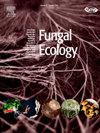Volatilome of Australian Ips grandicollis-associated ophiostomatoid fungi
IF 2.2
3区 环境科学与生态学
Q3 ECOLOGY
引用次数: 0
Abstract
The eastern five-spined bark beetle (Ips grandicollis) is an invasive pine pest in Australia. This beetle is associated with a community of symbiotic ophiostomatoid fungi, including Ceratocystiopsis sp., Ophiostoma ips, Sporothrix pseudoabietina and the recently described Graphilbum ipis-grandicollis. Fungal volatile organic compounds (VOC) can mediate fungal-insect-host interactions, including host finding. We used solid phase microextraction to examine variation in VOC profiles of beetle-associated ophiostomatoid fungi over time and how these profiles are influenced by supplemental host monoterpenes (α- and β-pinene). We found significant differences in VOC profiles of four-day-old fungal cultures among the four fungal species. Twenty-one known volatile compounds were identified up to eighteen days following inoculation. One culture of each of Ophiostoma ips and Graphilbum ipis-grandicollis released cis-verbenol when grown on media amended with (−)-α-pinene. However, verbenone was only released from Graphilbum ipis-grandicollis when grown on media amended with (−)-α-pinene. These compounds are components of aggregation and anti-aggregation pheromones of I. grandicollis, respectively. Our results suggest that ophiostomatoid fungi could contribute to the chemical ecology of I. grandicollis, dependent on time and environmental factors such as growth conditions since colonization.
澳大利亚大鼻病相关类蛇口真菌的挥发物
东部五棘树皮甲虫(Ips grandicollis)是入侵澳大利亚的松树害虫。这种甲虫与一个共生的类蛇口真菌群落有关,包括Ceratocystiopsis sp., Ophiostoma ips, Sporothrix pseudoabietina和最近描述的Graphilbum ipis-grandicollis。真菌挥发性有机化合物(VOC)可以介导真菌-昆虫-宿主相互作用,包括寻找宿主。我们使用固相微萃取法研究了甲虫相关的类蛇口真菌VOC谱随时间的变化,以及这些谱如何受到补充宿主单萜烯(α-和β-蒎烯)的影响。我们发现4天龄真菌培养物的VOC谱在4种真菌中存在显著差异。21种已知挥发性化合物在接种后18天被鉴定出来。当在添加了(−)-α-蒎烯的培养基上生长时,蛇瘤和大瘤草各有一个培养体释放出顺式马鞭酚。而马鞭草酮只有在添加了(−)-α-蒎烯的培养基上生长时才释放出来。这些化合物分别是大头草聚集和反聚集信息素的成分。我们的研究结果表明,类蛇口真菌可能对巨结肠的化学生态有贡献,这取决于时间和环境因素,如定植后的生长条件。
本文章由计算机程序翻译,如有差异,请以英文原文为准。
求助全文
约1分钟内获得全文
求助全文
来源期刊

Fungal Ecology
环境科学-生态学
CiteScore
5.80
自引率
3.40%
发文量
51
审稿时长
3 months
期刊介绍:
Fungal Ecology publishes investigations into all aspects of fungal ecology, including the following (not exclusive): population dynamics; adaptation; evolution; role in ecosystem functioning, nutrient cycling, decomposition, carbon allocation; ecophysiology; intra- and inter-specific mycelial interactions, fungus-plant (pathogens, mycorrhizas, lichens, endophytes), fungus-invertebrate and fungus-microbe interaction; genomics and (evolutionary) genetics; conservation and biodiversity; remote sensing; bioremediation and biodegradation; quantitative and computational aspects - modelling, indicators, complexity, informatics. The usual prerequisites for publication will be originality, clarity, and significance as relevant to a better understanding of the ecology of fungi.
 求助内容:
求助内容: 应助结果提醒方式:
应助结果提醒方式:


